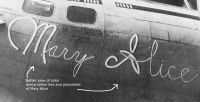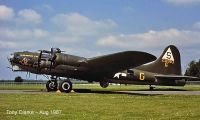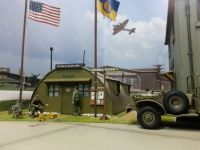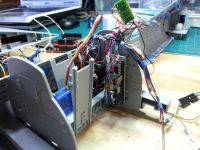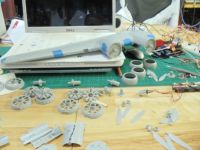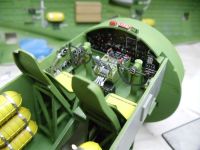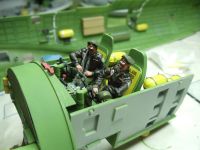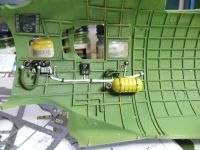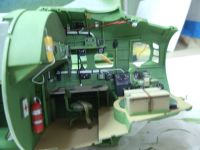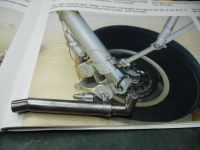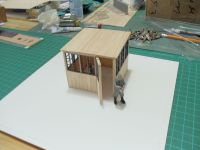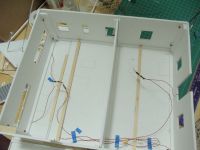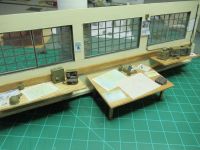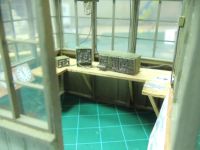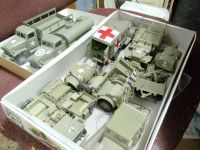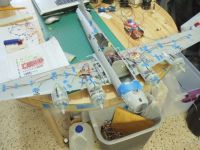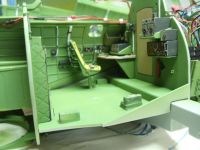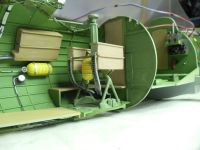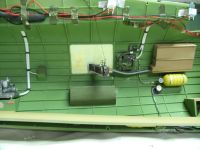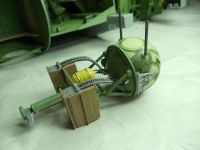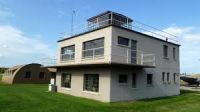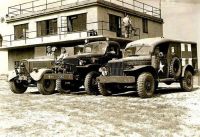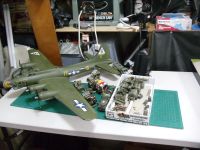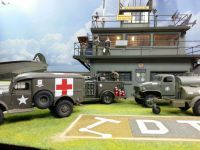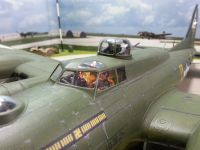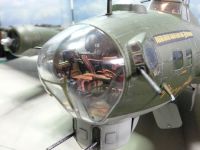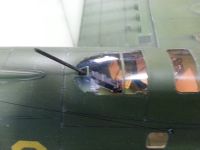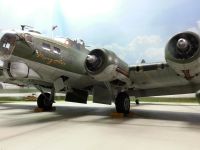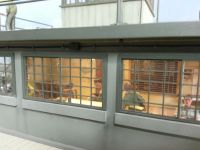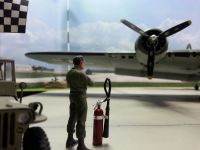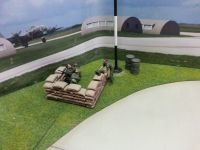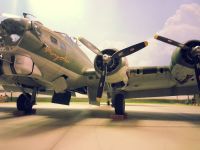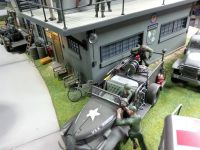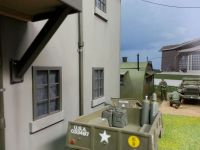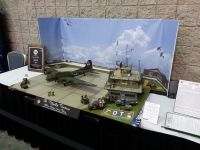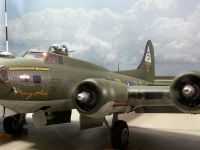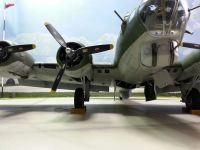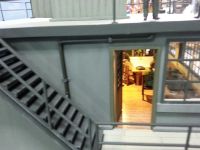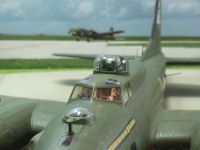HK Models 1/32 B-17G Diorama: "The Mighty Fortress: Where Heroes Have Flown"
By George Mustafa
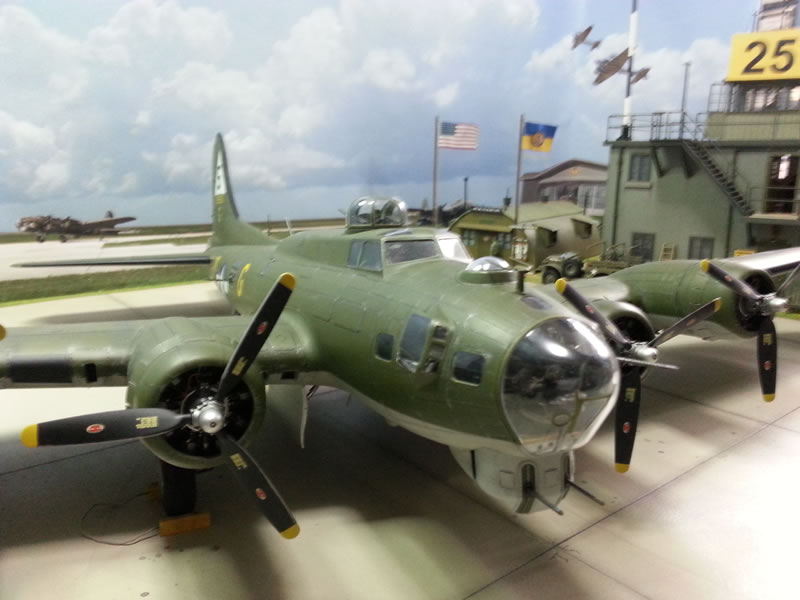
Introduction/Background
Following the landmark release of the first B-17G in 1/32 scale by HK Models in August 2013, I felt compelled to build an amazing diorama portraying this superb model in its own might, while paying tribute to the heroes that flew them in WWII during the most pivotal war this world has even known. It is an honor and a privilege to have had the inspiration to build this tribute to this formidable Flying Fortress and the heroes that flew them. Please accompany me to soar with them with this amazing diorama.
During late 1944 and early 1945 the B-17G took center stage in the air battle over Europe with continued bombing campaigns against the axis powers. Many versions of this mighty aircraft took to the skies to fight for freedom. Some of them became famous names back home and throughout history. Aircraft names like “Memphis Belle”, “Nine-O-Nine”, “Bit-O-Lace”, Little Patches”, and “Chou-Hound” are examples of these famous birds that currently have restored replicas flying in the air show circuits and also reside in museums around the world. These names are also the subject of the scale modeling where we can see these beautiful scale replicas in 1/48, 1/72 and 1/144 scales. Having been the first ever model kit to come out in 1/32 scale, I took to the task to create a replica of a bit lesser known name trying to stay away from the too often modeled subjects. Doing my research I found a striking aircraft that fought valiantly and survived the war. B-17G-35-BO "Mary Alice" of the 615th BS, 401st BG, USAAF, serial: IY-G (42-31983) circa 1944, was named by pilot Knight after his mother, Mary Alice Knight. His crew completed their tour on 25 June 1944. Other crews that regularly flew Mary Alice were piloted by 2nd Lt Harry Haskett, Lt R. W. Callaway, and 2nd Lt George Cacraft. The plane was badly damaged many times, reportedly suffering more repairable battle damage than any other 8th Air Force B-17. The plane eventually flew 98 missions and was scrapped at Kingman, AZ after the war.
The B-17G on display at the Imperial War Museum, Duxford, England, is painted to represent Mary Alice. Boeing B-17G-95-DL/Mary Alice /231983G/IY-G/(F-BDRS).
The Diorama
Making a large and complex diorama like this one is no easy task, however in the end is a very rewarding one. From planning to finished product it took me one year, almost to the day and over 1200 hrs of work…lots of work, and it paid off by winning the Popular Best of Show during the recent IPMS-USA 50th Anniversary Nationals in Hampton Va.
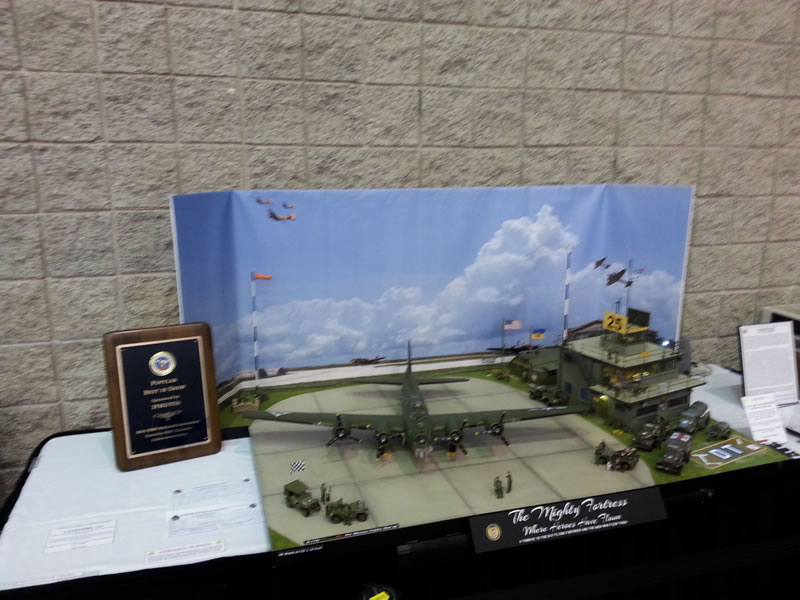
The diorama presents B-17G Mary Alice parked at the transient ramp near the control tower at RAF Deenethorpe Airfield AAF Station 128 in the summer of 1944 executing a full engine run up prior to the day’s mission after no.1 engine was repaired. The B-17 model incorporates an Arduino Leonardo programmable micro-controller that runs all four engines from start up (just like the real P&W 1820 engines), to idle, then to full RPM, back to idle and then shut down. The controller also runs all the illumination: interior lights, navigation lights, IFF identification lights and landing lights. All these special effects were programmed into the Arduino controller to give the B-17 model life. To compliment these effects I also incorporated sound. Thanks to the folks that owned the real life B-17G Chuky at the Military Aviation Museum in Virginia beach who posted a great video of a full engine run up done some years ago, I was able to edit the sound and the cockpit voices and adapted them with new engine sounds into this project. Additionally, I decided to have control surfaces and bomb doors things moving as well. I used micro servos with a separate micro controller to add the special effect. In the 3 minute action sequence the engines start and run up to idle. Prior to full power run up, the flaps rise into the wings and the bomb bay doors close. When the engines go to full power, the elevators rise few degrees to compensate for the hurricane wind produced by the engines that could lift the tail sitting tail, and the rudder deflects to the right to compensate for the torque. The IFF (Identification Friend or Foe / position lights) on top of the dorsal vertical stabilator fillet and on top of the rear horizontal stabilator light up in their combination blue and white. Likewise the three identification lights, red, yellow green on the belly of the plane, just aft the ball turret also light up. The landing lights come to life during the run up as well. The whole scene takes about 4 minutes and following the voice/sound recordings, before the pilots shut down the engines, the elevators and rudder return to their neutral position, the bomb bay doors open again and the flaps are lowered to their formal position. All lights shut off and then all four engines shut down. These special effects really add life to the marvelous model and give the viewer a taste of what running a B-17 engines was all about. The whole scene is preceded by a powerful song called “Memphis belle” and a short narration of what the mighty Fortress is all about, and after the shut down, the scene ends with a bit more of the music and a closing statement about the Fortress and our heroes.
The rest of the diorama, on the other hand, incorporates a fully scratch built control tower following the general design of these towers for the AAF field in England at the time. The tower has a complete second story illuminated control office with a myriad of details inside. Also the roof added tower booth also illuminated and with a myriad of details inside, plus the radio mast, the weather vane, runway signs and much more! To add to the scene, there are 36 figures and eight vehicles to include jeeps, beeps, fire truck, tanker truck and an ambulance like they typically had near the towers back then. Additionally, there are other elements like water tanks, bicycles, oil drums, tool boxes, chairs, wheel chucks, a sand bag defensive position with a 50 cal and informational signs. A 48 star US Flag, (as was the norm in 1944), and the Eight AF flag as was the norm in the day, fly on flag poles right in front of the also scratch built Nissen Hut that serves as the 401BG operations center and which is located right behind the tower. There is a wind sock on a large pole at the rear of the scene as well. To top all off, I incorporated a backdrop scene (my design) of an airfield with hangar, huts, runway and other b-17’s against a nice cloud background which really adds great depth value and authenticity to the whole scene.
To create this amazing diorama I used the following:
- HK models 1/32 B17G model (released for sale August 2013)
- Eduard PE sets (all of them except the flaps. I needed to have the original ones for the servos)
- Eduard Brassin tires
- HK models metal landing gear (modified to lower the extended oleos to the correct 3” distance when the B-17 was on the ground, hence the model has the correct stance vs. the original ones which makes the model look odd being so high on its gear!
- Profimodeller brass gun barrels
- Tamiya, Revell, Italeri and AFV vehicles. I used a die cast fire truck that was militarized due to the lack of an 1/35 fire truck model of the era.
- Tamiya, Revell and Verlinden figures
- Legend Production Memphis Belle crew set figures and one toy dog (from my grandson’s box!)
- Tamiya accessories
- Bass wood, balsa wood, Foam Board, brass tubing, doll house windows frame and stair case for the tower and Nissen hut. Home printed flags and wood dowels for poles. Scratch built wind sock and an Evergreen tubing for pole. MiniArt plastic 1/35 metal stair.
- Artificial grass mat and accessories
- Six 18 x 18 inches 1.5 deep bare wood painters frame, hooked together underneath with removable bolts to form the base. I treated and painted the wood itself to represent the tarmac. Using the joint lines I sub-divided the panels into 9” squares to represent the tarmac slabs. This was necessary for logistical and transportation issues, hence the slab lines are not at 45 degree angle.
- Pololu’s micro servos and programmable servo controller
- Programmable Arduino Leonardo micro controller to run the aircraft engines and lights
- Programmable Arduino Uno and Arduino MP3 player to run the sound and provide the power to the onboard Leonardo
- Four Airfix 1.5v electric motors for the engines
- Home built H bridge motor controllers (inside each wing)
- LED lights
- Cirduit connectors (wings are removable for travel and connectors are needed)
- One programmable micro controlled relay board to turn on and off the whole special effects
- One 78”x 31” backdrop printed on banner material for strength and durability and placed over a set of foldable presentation carton boards bolted to the rear of the base
- Two sets of speakers for the sound effects.
The Model
This landmark release of the B-17 in 1/32 scale was one of the many all time dreams of modelers around the world that thanks to all the folks that started and to HK models that finished this extremely well done rendition of this venerable aircraft, we finally have a gigantic B-17 in 1/32 scale!
HK Model did a terrific job in the engineering and design of this great model. The parts fit are excellent, the details are abundant and the finished model becomes a jewel. I am especially impressed with the fact that the designers thought out of the box and designed a wing to fuselage locking system that not only allows the wings to fit perfectly, but are also removable for storage or transportation as it happened to me that I had to hand carry the model, partially disassembled from my home in PR to the IPMS Nationals in Hampton Virginia and back home as well.
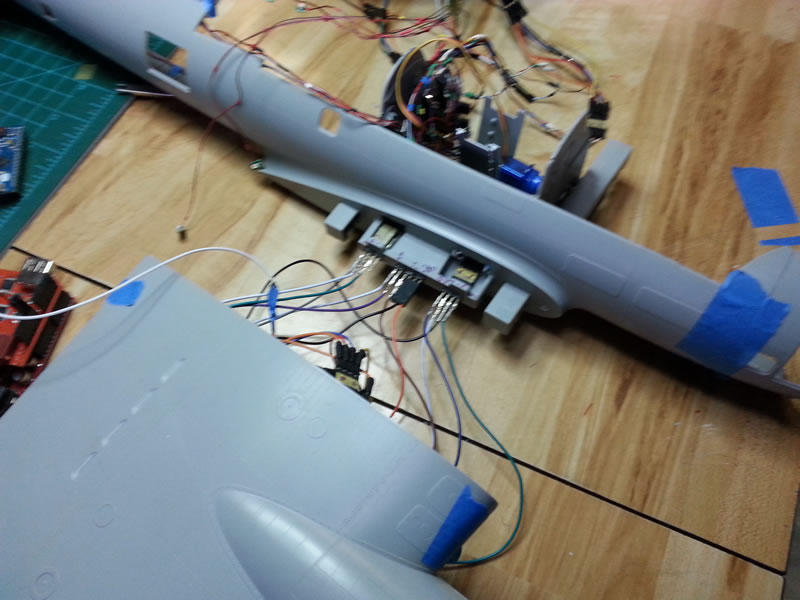
The model is very complete and out of the box looks terrific, however, I decided to add the great Eduard PE set to enhance the interiors and exteriors. The only sets I got and didn’t use were the excellent Flap set, because I decided to have these move and needed the sturdy plastic parts instead of the extremely fine but fragile Eduard set. The other one is the bomb bay set. I decided not to use it since I was to use the bomb bay to house the two controllers. In the end I was able to fit the controllers and add few of the aircraft ordnance to disguise the controllers and to add more detail to a fully loaded bomber.
Assembly went out without a hitch. Parts fit was excellent and required just very little putty to seal few minor gaps, some due to the addition of servos, wiring and controllers. I modified the engine mounts to fit the excellent Airfix electric motors, the ones made for their 1/24 scale line. These motors incorporate a capacitor to regulate the electric kick-back of the motors when powering down which, in conjunction to a homemade H-bridge controller/rectifier helped to avoid damaging the Arduino controller and provided the smooth line to the Pulse Width Modulation (PWM) signal that makes the motors spin slowly, accelerate, decelerate and stop on command from the program I wrote for the controller. Also, these motors come with a plastic extension that fits the motor and required just a slight grind down of the propeller hubs to fit. In the process of adapting the electric motors I had to extensively modify the engine mount in the wings. The end product is that each motor is mounted to the cowl flap assembly and this fitted to the engine pylons with bolts and nuts. They are removable if need so.
Another modification I had to make was the landing gear. The HK Models plastic and metal rendition have an extended oleo strut. If left like that the finished model will not have the right stance of a B-17 sitting on the ground. As per references and the original B-17 tech manuals, the oleos on the ground must not have more than three inches showing. To fix this I cut the oleo of each gear metal part at its uppermost point, and then drilled the gear leg to fit the oleo inside thus reducing the length to approximately three inches in scale. The end result is that this model has the correct stance of a loaded B-17 on the ground.
I painted the model using Tamiya OD #2 and Royal gray. The colors matched those in the references very well. After painting I sanded the finish with #3600 and 4000 micro mesh to smooth out the roughness of the paint. After that I applied Future to give the model a very glossy finish for the decals. I used the stencil set and national insignia from Kits World Decals. The letters, tail number and plane name where painted using stencils made in my vinyl cutter. The white triangles were also painted. The “S” inside the triangles I printed on decal sheet at home. After decaling I applied another coat of Future to seal the decals. Following that I applied some weathering with Doc O’Brien’s set and then used Alclad Matte coat to seal everything in and give the plane a smooth flat finish. I sanded this finish with 4000 micro mesh to take the roughness out and make it very smooth and uniform. I finished by creating some silver scratches and wear on the paint with a silver Prismacolor pencil. The panel lines were highlighted with a water based extra fine point Sharpie and a wash of black and raw umber acrylics from Apple Barrel.
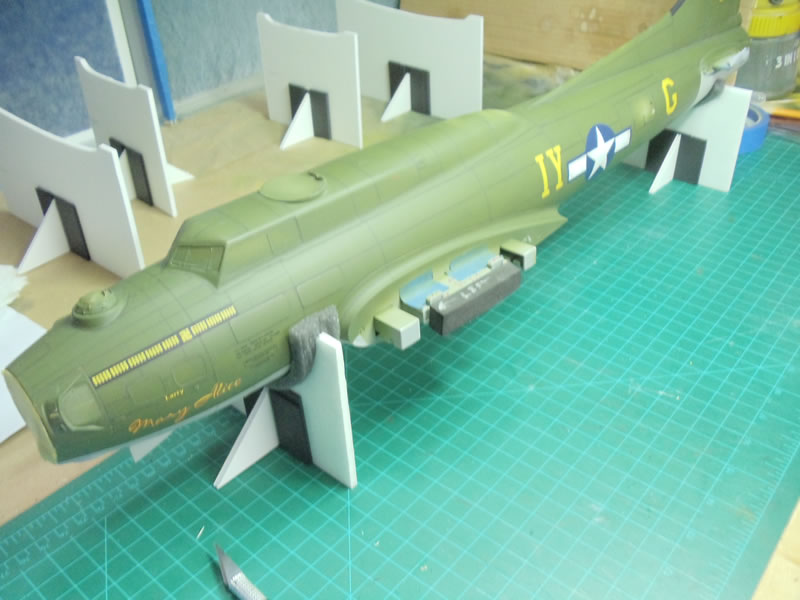
I used the excellent Eduard Brassin tire/wheel set that gave the model a much better rendition of its massive tires. The power cables to run the Arduino and the servo micro-controllers hook up under each tire—right side 9v power for Arduino—left tire 5v 1 amp power for the servos.
Other Elements
As mentioned above, the control tower is scratch built. I found many excellent pictures of the original towers and took the 1/72 Airfix tower and measured up its dimensions to 1/32 scale. I drew all the elements of the tower walls, ceilings, floors and balcony and printed heavy stock paper from which I cut the pieces from white foam board. Since I would have to travel with the tower and knowing it would end up being a large building, I decided to make it modular, hence it can be assembled and disassembled at will. I used doll house plastic window frames and the excellent MiniArt 1/35 metal staircase. The railing around the ceiling and the balcony was done with brass tubing soldered together in a jig I made for it. To add more interest to the tower, I decided to scratch build all the interior office in the second floor and the top most tower booth. Using balsa wood, and printed items like wall clock, barometer, etc I dressed up the office. I used the Verlinden radio equipment to add to the office and booth. I decided to illuminate the tower interior and the booth to allow for the viewing people to appreciate the level of detail inside. I used 3mm warm white LEDs. Additionally I scratch built three working reflector spotlights using LEDs. I finally dressed up the tower to resemble the ones used throughout the RAF and AAF bases in WII.
To add interest to the scene I scratch built a Nissen hut out of Balsa wood and added the outside siding from printed stock. I used plastic tubing to recreate the smoke stacks out of the hut and the tower as well. I also illuminated the Nissen Hut but added frosting to the windows for I did not build any interior details.
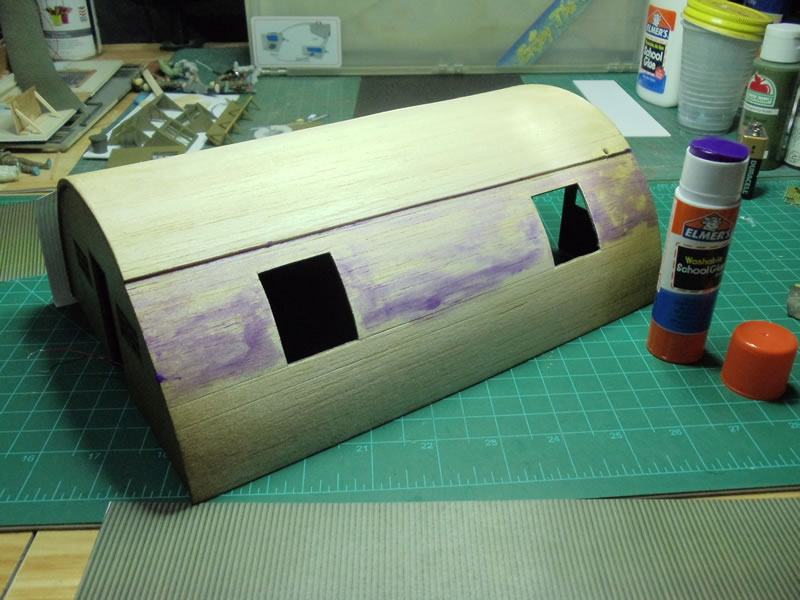
To surround the hut I built two flag poles from wood dowels and added the American flag used in 1944 with only 48 stars. Also I added the Eight AF official flag as used in the day.
The scene is surrounded by action. Not only the aircraft, but I added 36 figures, eight motor vehicles, trailers and equipment as well. I used a combination of figures to include Verlinden, Legend production, Tamiya and other resin figures. All the vehicles, trailers and bicycles used are Tamiya, Italeri, Revell and AFV. I built the vehicles OOB and dressed them up a bit with a Follow Me flag and radio equipment or specific placards for the scene. The bomber crew, seating on a jeep awaiting the end of the run-up is the “Memphis Belle” crew from Legend Productions. I used two of the seating crew and adapted them to the B-17 cockpit and set the rest outside, plus a small plastic dog (from my grandson’s toy stash to add interest). Additionally, due to the lack of a plastic model of true fire truck of the time I used a die-cast truck which I repainted and adapted to the scene. Around the whole scene you will find equipment, oil drums, tool boxes, fire extinguishers, extra wheel chucks and ammo boxes and even a power transmission pole with power lines to both buildings. The final touch was to add a 50cal emplacement in the left rear portion of the scene, next to the scratch built wind sock, with two figures and other details.
The base is a set of six 18”x18”x1.5” wood frames to form a complete base of 54”x36” that houses the scene. I bolted these together with long bolt and washers tightening them with butterfly nuts for ease of assembly/disassembly. Usually when we do tarmacs we design and create the concrete slabs at an angle from the base ends, meaning that usually the labs and separation lines between the slabs are at 30 to 45 degrees to the angular end of the base. In this case I decided to use the lines produced by the joints of the wood frames and to my fortune, I was able to additionally sub divide each frame into four slabs of nine inches each (very close to the size of the real life slab in scale). So I took advantage of the joint lines and designed the rest of the tarmac around them which spared me a lot of issues adding removable tarmac parts that could have been damaged during transportation. I sanded and coated the wood with a plastic varnish to hide the wood grain and then painted them to match the approximate color of the concrete. Using powders I applied some weathering and highlighted the slab sheer lines. With diluted acrylics I added the oil stains and other marks. I used ready grass mat to create the grassy area and used a sand mat to create the back road, all highlighted and weathered.
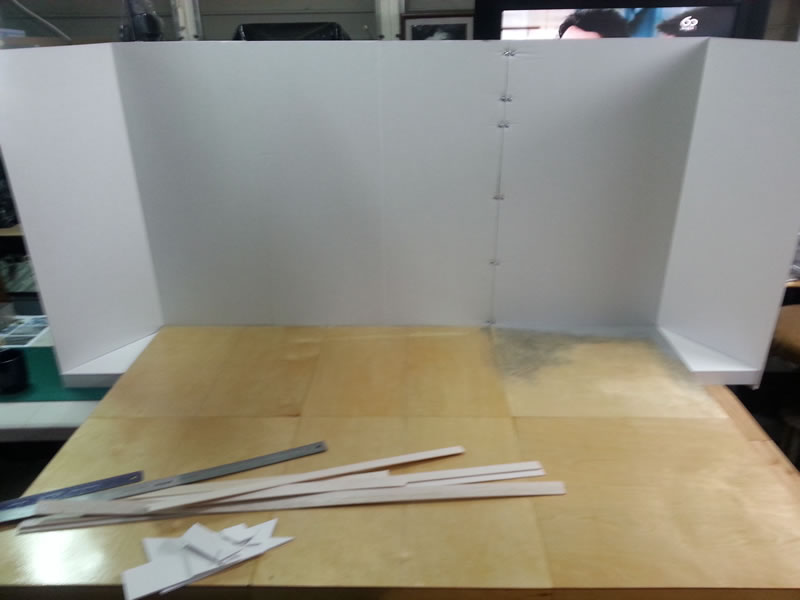
Finally, to add that special touch, I designed and had it printed in banner material a backdrop that lends a realistic touch to the scene. The banner is taped to a set of foldable presentation cartons which in time are bolted to the wood frames behind the scene—all this also removable.
Located under the right front frame are the Arduino Uno main micro controller with and MP3 module and the master power control timer from which an extension exits to the rearmost frame to connect the two power supplies. Hooked to the MP3 module are two sets of desktop speakers that lends the sound output for the presentation.
The sounds and music came from different sources in the internet. The song “Memphis Belle”, nothing to do with the movie, I found at a war related music web page. The author is unknown, but I credit whoever did it with the highest honors of having produced such an emotional song. The voices of for the pilots used in the scene came from an excellent video of a full run-up done to the B-17G Chuky at the Military Aviation Museum in Virginia Beach in about 2012. Many thanks to the folks at the museum for such wonderful video from which I extracted some of the conversation and the run up sequence and timing. The engine starting sound, idle sound and full run up sound and shutting down sound came from various videos or sound bit found throughout the web — my gratitude to all the folks who produced them. I edited these sound bites and mixed them to produce the final effect.
Last but not least, my profound gratitude to the folks at the Yankee Air Force/Museum for their wonderful promotional video “Where Heroes Have Flown” that inspired my work. Their excellent narration inspired me to concoct a version that would really add value to the tribute I was building to honor our heroes. I praise and value the YAF for keeping these legends aloft and for honoring those heroes that flew and maintained them.
Putting It All Together
As mentioned above, this entire scene had to be modular to allow to be disassembled for travel. The six wood frames bolt together to form the base and the tower building can be re-assembled into shape. The HKM B-17 has this excellent feature that the wings and horizontal stabilator, can be removed, a must for me! Additionally, I made the props, tail cone, nose glass, gun barrels, antennas and gun turrets also removable for transport.
It takes few hours to re-assemble the scene. Once all elements are in place, the last bit to be added is the B-17. Two micro connectors hook up through a hole in the wood base to under each of the mail wheels to power up the two sets of electronics on board: 9v 1amp for the servo microcontroller and the Arduino that run the props and lights and another connection for a 5v 1amp supply to run the servos themselves.
Lastly, to operate everything on the right side of the base is a black box with a red button that can be momentarily depressed and which will initiate the action sequence.
I hope you will enjoy this amazing diorama. Many thanks for taking the time to soar with us in memory of our heroes.
A video is available to be viewed on YouTube (link), or below:
Respectfully,
George R Mustafa
George.mustafa2@gmail.com
© George Mustafa 2014
This article was published on Tuesday, August 19 2014; Last modified on Friday, August 26 2016

